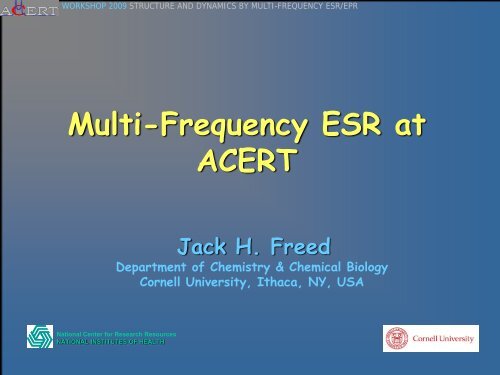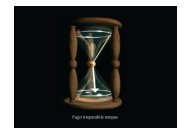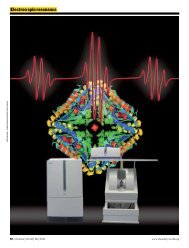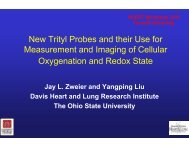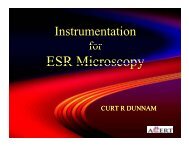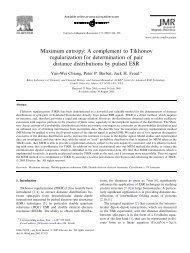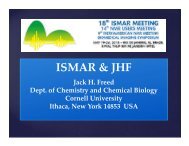Multi-Frequency ESR at ACERT - acert - Cornell University
Multi-Frequency ESR at ACERT - acert - Cornell University
Multi-Frequency ESR at ACERT - acert - Cornell University
You also want an ePaper? Increase the reach of your titles
YUMPU automatically turns print PDFs into web optimized ePapers that Google loves.
WORKSHOP 2009 STRUCTURE AND DYNAMICS BY MULTI-FREQUENCY <strong>ESR</strong>/EPR<br />
<strong>Multi</strong>-<strong>Frequency</strong> <strong>ESR</strong> <strong>at</strong><br />
<strong>ACERT</strong><br />
Jack H. Freed<br />
Department of Chemistry & Chemical Biology<br />
<strong>Cornell</strong> <strong>University</strong>, Ithaca, NY, USA<br />
N<strong>at</strong>ional Center for Research Resources<br />
NATIONAL INSTITUTES OF HEALTH
WORKSHOP 2009 STRUCTURE AND DYNAMICS BY MULTI-FREQUENCY <strong>ESR</strong>/EPR<br />
I. Motional Dynamics<br />
•Introduction: <strong>Multi</strong>frequency <strong>ESR</strong><br />
•Anisotropic Motion and<br />
High <strong>Frequency</strong> <strong>ESR</strong><br />
•Protein Dynamics<br />
•T4 Lysozyme<br />
•Slowly Relaxing Local Structure<br />
Model<br />
•Atomistic Models<br />
•Overall Assessment<br />
•Membrane Dynamics<br />
•Gramicidin in Lipid Membrane<br />
II. Methods<br />
•Quasi-Optical <strong>ESR</strong><br />
•Stochastic Liouville Equ<strong>at</strong>ion<br />
III. 2D-<strong>ESR</strong>: 2D-ELDOR<br />
•Pulse Sequences<br />
•Membrane Studies<br />
•High Frequencies: 95 GHz<br />
•Time-Scale Challenges<br />
•Summary<br />
IV. Comput<strong>at</strong>ional Challenges:<br />
2D-ELDOR<br />
•Lanczos Algorithm and 2D-<strong>ESR</strong><br />
•The Challenge of 2D-ELDOR <strong>at</strong><br />
High Frequencies<br />
•The New QMR Method<br />
V. 2D-Double Quantum Coherence:<br />
Orient<strong>at</strong>ional Resolution<br />
VI. Rigid-Limit: Magnetic Tensors<br />
•Polarity Gradients in Membranes<br />
•Charge Transfer Complexes
WORKSHOP 2009 STRUCTURE AND DYNAMICS BY MULTI-FREQUENCY <strong>ESR</strong>/EPR<br />
Molecular Dynamics by <strong>ESR</strong><br />
Wh<strong>at</strong> is special about <strong>ESR</strong>, in particular spin-label <strong>ESR</strong>?<br />
(e.g. compared to NMR)<br />
1. <strong>ESR</strong> is much more sensitive per spin (than NMR).<br />
2. In time domain experiments <strong>ESR</strong>’s time-scale is nanoseconds.<br />
(NMR’s is milliseconds)<br />
3. The spin-label spectrum is simple, & can focus on a limited number of<br />
spins.<br />
4. <strong>ESR</strong> spectra change dram<strong>at</strong>ically as the tumbling motion of the probe<br />
slows, thereby providing gre<strong>at</strong> sensitivity to local “fluidity”.<br />
(In NMR nearly complete averaging occurs, so only<br />
residual rot<strong>at</strong>ional effects are observed by T 1 & T 2 .)<br />
5. <strong>Multi</strong>-frequency <strong>ESR</strong> permits one to take “fast-snapshots” using very<br />
high-frequencies & “slow-snapshots” using lower frequencies to help<br />
unravel the complex dynamics of bio-systems.<br />
6. Pulsed <strong>ESR</strong> methods enable one to distinguish homogeneous<br />
broadening reporting on dynamics vs. inhomogeneous broadening<br />
reporting on local structure.
PDT/Toluene <strong>at</strong> 250GHz<br />
<strong>ESR</strong> Spectra in a Fluid<br />
Motional Narrowing<br />
Regime<br />
Slow Motional<br />
Regime<br />
Rigid Limit
<strong>Multi</strong>-<strong>Frequency</strong> <strong>ESR</strong> Simul<strong>at</strong>ion<br />
A motional process th<strong>at</strong> looks fast <strong>at</strong><br />
lower frequencies….<br />
For complex dynamics<br />
of proteins<br />
Rot<strong>at</strong>ional<br />
Tumbling Time:<br />
τ R = 1.7 × 10 -9 s<br />
The slow overall &<br />
collective motions<br />
will show up best <strong>at</strong><br />
lower frequencies.<br />
Whereas<br />
The fast motions will<br />
show up best <strong>at</strong><br />
higher frequencies.<br />
...will look slow <strong>at</strong> higher frequencies
WORKSHOP 2009 STRUCTURE AND DYNAMICS BY MULTI-FREQUENCY <strong>ESR</strong>/EPR<br />
Sensitivity to Anisotropic<br />
Motional Dynamics: High <strong>Frequency</strong><br />
Example: complexes of cyclodextrins with spin-labeled f<strong>at</strong>ty acids
WORKSHOP 2009 STRUCTURE AND DYNAMICS BY MULTI-FREQUENCY <strong>ESR</strong>/EPR<br />
<strong>ESR</strong> Spectra of aqueous solutions of T4 Lysozyme spinlabeled<br />
<strong>at</strong> mutant site 72 <strong>at</strong> different frequencies &<br />
temper<strong>at</strong>ures*<br />
R1 <strong>at</strong> Site 72<br />
Experiment<br />
Fit<br />
131<br />
32 o C<br />
22 o C<br />
72<br />
69<br />
12 o C<br />
44<br />
2 o C<br />
3283 3303 3323 3343 3363 33740 33800 33860 33920 33980 60765 60865 60965 61065 61165 84045 84185 84325 84465 84605<br />
9 GHz 95 GHz<br />
B ( G )<br />
170 GHz 240 GHz<br />
* V s ~ 0.2μL
WORKSHOP 2009 STRUCTURE AND DYNAMICS BY MULTI-FREQUENCY <strong>ESR</strong>/EPR<br />
Ribbon model of T4 lysozyme showing R1 side chain <strong>at</strong> sites 72 (in<br />
middle of rigid 6 turn helix) & 131 (on more flexible 2½ helix)<br />
with dynamic parameters of SRLS model indic<strong>at</strong>ed<br />
Spin labels R1 & R2<br />
Z<br />
R1: Z = H<br />
R2 : Z = CH 3<br />
restricted<br />
Time scale
The SRLS Model<br />
c<br />
R ||<br />
0<br />
R ⊥<br />
g-tensor frame<br />
c<br />
R ⊥<br />
0<br />
R ||<br />
R ||<br />
g ZZ<br />
0<br />
β MG<br />
g XX<br />
Ф<br />
g yy<br />
Restricted<br />
Internal<br />
Motion<br />
MOMD Model:<br />
0<br />
R ||<br />
and<br />
c<br />
R ⊥<br />
0
• Overall protein reorient<strong>at</strong>ions<br />
• Side chain dynamics<br />
Modified SLE:<br />
L( Ω D<br />
)<br />
Γ( Ω D<br />
)<br />
−1<br />
2<br />
( )<br />
T Ω D<br />
• Model system: R1 linked to poly-Ala a-helix<br />
• Conform<strong>at</strong>ional analysis ⇒ stable conformers<br />
⇒ chain dynamics<br />
No Free Parameters<br />
EPR spectra of R1 in α-helix domain<br />
⇐<br />
( Ω , t)<br />
∂t<br />
= −i<br />
L<br />
Liouville superoper<strong>at</strong>or with magnetic tensors<br />
partially averaged by chain dynamics<br />
Diffusion oper<strong>at</strong>or for overall<br />
protein tumbling<br />
Adding Atomistic Perspective to<br />
Mesoscopic (SLE) Approach *<br />
∂ρ<br />
Linewidth contribution from chain<br />
dynamics (Redfield theory)<br />
D<br />
Assumption: Conformers with low barriers exhibit<br />
fast exchange. Conformers with high barriers<br />
exhibit no exchange.<br />
[ ] ρ( Ω , t)<br />
−1<br />
( Ω ) ρ( Ω , t) − T ( Ω ) + Γ( Ω )<br />
D<br />
D<br />
2<br />
D<br />
D<br />
* F. Tombol<strong>at</strong>o, A. Ferrarini, J.H. Freed<br />
D
Molecular Dynamics Simul<strong>at</strong>ions: An Atomistic View *<br />
Spin label<br />
dynamics<br />
Experimental<br />
<strong>ESR</strong> spectrum<br />
R1 Side-Chain<br />
containing<br />
nitroxide<br />
moiety<br />
Protein X-ray<br />
structure<br />
time<br />
domain<br />
Calcul<strong>at</strong>ed<br />
<strong>ESR</strong> spectrum<br />
Atomistic MD<br />
simul<strong>at</strong>ions<br />
* D. Sezer, J. H. Freed & B. Roux
WORKSHOP 2009 STRUCTURE AND DYNAMICS BY MULTI-FREQUENCY <strong>ESR</strong>/EPR<br />
Overall Assessment of Molecular<br />
Dynamics by <strong>Multi</strong>-<strong>Frequency</strong> <strong>ESR</strong><br />
• <strong>Multi</strong>-frequency approach supplies “snapshots” <strong>at</strong> different<br />
time-scales, but also provides “snapshots from different<br />
angles”: hf-tensor <strong>at</strong> lower frequencies; g-tensor <strong>at</strong> higher<br />
frequencies.<br />
• SRLS is a “mesoscopic” approach with fewer fitting<br />
parameters than <strong>at</strong>omistic ones, but still requires the multifrequency<br />
d<strong>at</strong>a to fit numerous parameters.<br />
• The approach of Tombol<strong>at</strong>o et al. adding “<strong>at</strong>omistic” detail to<br />
the SLE is a way to improve on the SRLS model. Its<br />
predictions are in reasonable agreement with the SRLS<br />
analysis of the multi-frequency spectra.
WORKSHOP 2009 STRUCTURE AND DYNAMICS BY MULTI-FREQUENCY <strong>ESR</strong>/EPR<br />
Overall Assessment of Molecular<br />
Dynamics by <strong>Multi</strong>-<strong>Frequency</strong> <strong>ESR</strong><br />
• Tombol<strong>at</strong>o et al: Side-chain motion of MTSSL is more<br />
complex than “mesoscopic” approach of SRLS.<br />
• Fully <strong>at</strong>omistic MD study of Sezer et al. led to excellent fits<br />
to several multi-frequency spectra, but is more difficult to<br />
reconcile with SRLS analysis of extensive multi-frequency<br />
spectra.<br />
• Sezer et al. provide explicit evidence th<strong>at</strong> even successful<br />
fitting to extensive multi-frequency spectra is not in itself a<br />
guarantor of uniqueness of fit.<br />
• We were not able to achieve a clear separ<strong>at</strong>ion between<br />
MTSSL side-chain motions and local backbone motions.
WORKSHOP 2009 STRUCTURE AND DYNAMICS BY MULTI-FREQUENCY <strong>ESR</strong>/EPR<br />
Overall Assessment of Molecular<br />
Dynamics by <strong>Multi</strong>-<strong>Frequency</strong> <strong>ESR</strong><br />
• One can, in general, fit an individual single frequency<br />
spectrum with somewh<strong>at</strong> higher quality of fit and perhaps<br />
fewer parameters than emerges in the fitting of spectra <strong>at</strong><br />
several different frequencies.<br />
However, given the spectra <strong>at</strong> the different frequencies<br />
provide different perspectives on the molecular motions, and<br />
therefore taken together provide a fuller picture of the<br />
dynamics, then they should all be given significant weight.<br />
• A major achievement in this study is th<strong>at</strong> consistently good<br />
fits are obtained <strong>at</strong> all frequencies with the same set of fitting<br />
parameters.
WORKSHOP 2009 STRUCTURE AND DYNAMICS BY MULTI-FREQUENCY <strong>ESR</strong>/EPR<br />
Form<strong>at</strong>ion & dissoci<strong>at</strong>ion of head-to-head dimers by<br />
GAsl in DPPC (aligned samples)<br />
aligned membrane: 0 o orient<strong>at</strong>ion<br />
9.6 GHz<br />
310K<br />
295K *<br />
288K<br />
Spin labeled gramicidin A in<br />
DPPC above the L β -P β transition<br />
point starts to form channels.<br />
3.34 3.36 3.38 3.40 3.42 3.44<br />
B [ kG ]<br />
170 GHz<br />
310K<br />
288K *<br />
The conclusion, which could be made<br />
<strong>at</strong> 9 GHz only after simul<strong>at</strong>ions……..<br />
288K<br />
6.06 6.07 6.08 6.09 6.10<br />
B [ T ]<br />
* hysteresis st<strong>at</strong>e, 15 min. after<br />
exposure <strong>at</strong> 310 K<br />
§ equilibrium st<strong>at</strong>e, 24 h after exposure<br />
<strong>at</strong> 310 K<br />
…..is very clear <strong>at</strong> 170 GHz.<br />
the spectral intensity shifts from the XY- to the<br />
Z- region & back upon performing a cooling &<br />
he<strong>at</strong>ing cycle.
Quasi-optical design<br />
Induction mode bridge<br />
Variable temper<strong>at</strong>ure<br />
WORKSHOP 2009 STRUCTURE AND DYNAMICS BY MULTI-FREQUENCY <strong>ESR</strong>/EPR<br />
170/240 GHz Bridge<br />
Source<br />
170GHz source:<br />
40mW output power<br />
165-175GHz BW<br />
Bridge<br />
Excit<strong>at</strong>ion<br />
p<strong>at</strong>h<br />
Detection<br />
p<strong>at</strong>h<br />
240GHz source:<br />
20mW output power<br />
235-245GHz BW<br />
Differential screw tuning drive<br />
Curved refocusing mirror<br />
Sample Stage<br />
Coupling mesh
WORKSHOP 2009 STRUCTURE AND DYNAMICS BY MULTI-FREQUENCY <strong>ESR</strong>/EPR<br />
Schem<strong>at</strong>ic Diagrams of Quasi-Optical Bridges *<br />
Reflection Bridge<br />
Induction Bridge<br />
*From Appl. Magn. Res (1999)
WORKSHOP 2009 STRUCTURE AND DYNAMICS BY MULTI-FREQUENCY <strong>ESR</strong>/EPR<br />
Stochastic Liouville Equ<strong>at</strong>ion<br />
Assuming the “st<strong>at</strong>istical independence” of the spin evolution and the molecular<br />
tumbling we may combine<br />
the spin-density m<strong>at</strong>rix, , and<br />
ρ( t)<br />
the orient<strong>at</strong>ional distribution function,<br />
( Ω t)<br />
P ,<br />
a combined spin and orient<strong>at</strong>ional distribution function,<br />
, into<br />
ρ( Ω,t)<br />
, obeying:<br />
which is the stochastic Liouville equ<strong>at</strong>ion (SLE).<br />
‣ Note, th<strong>at</strong> we recover the normal density m<strong>at</strong>rix by averaging<br />
over all :<br />
Ω<br />
and we recover<br />
ρ<br />
∂ρ<br />
∂t<br />
( Ω,<br />
t) = −i[ Hˆ<br />
, ρ] − ˆΓ<br />
( Ω,<br />
t)<br />
() t = ρ( Ω,<br />
t) Ω<br />
P ( Ω,t)<br />
Ωρ<br />
by setting the spin(s) S, I = 0.<br />
ρ( Ω,t)
WORKSHOP 2009 STRUCTURE AND DYNAMICS BY MULTI-FREQUENCY <strong>ESR</strong>/EPR<br />
Basic Pulse Sequences in 2D-<strong>ESR</strong><br />
COSY<br />
pulses<br />
coherence<br />
p<strong>at</strong>hways<br />
2D-ELDOR<br />
pulses<br />
coherence<br />
p<strong>at</strong>hways
WORKSHOP 2009 STRUCTURE AND DYNAMICS BY MULTI-FREQUENCY <strong>ESR</strong>/EPR<br />
2D-ELDOR
WORKSHOP 2009 STRUCTURE AND DYNAMICS BY MULTI-FREQUENCY <strong>ESR</strong>/EPR<br />
2D-<strong>ESR</strong> <strong>at</strong> 95GHz<br />
with High-Power<br />
Pulses
WORKSHOP 2009 STRUCTURE AND DYNAMICS BY MULTI-FREQUENCY <strong>ESR</strong>/EPR<br />
Spin-labeled Gramicidin A in Oriented Membrane (DPPC)<br />
•Slow motional nitroxyl<br />
spectrum <strong>at</strong> 7 o C.<br />
•Orient<strong>at</strong>ion selection <strong>at</strong><br />
95 GHz (3.2 mm)<br />
• g z parallel to membrane<br />
normal (z-ordered)<br />
B 0 || n<br />
g z g y g x<br />
B 0 ⊥ n
WORKSHOP 2009 STRUCTURE AND DYNAMICS BY MULTI-FREQUENCY <strong>ESR</strong>/EPR<br />
Spin-labeled Gramicidin A in Oriented Membrane<br />
2D-ELDOR (echo-like component) <strong>at</strong> 7C o<br />
T = 50 ns<br />
Slow motional regime -<br />
coverage ~350 MHz<br />
A z-1<br />
A z 0<br />
A z+1<br />
g y<br />
g x<br />
A z-1<br />
A z 0<br />
A z+1<br />
g y<br />
T = 200 ns<br />
B 0 || n
WORKSHOP 2009 STRUCTURE AND DYNAMICS BY MULTI-FREQUENCY <strong>ESR</strong>/EPR<br />
Summary: 2D-ELDOR <strong>at</strong> cm and mm Waves<br />
• It enables one to distinguish between homogeneous broadening<br />
(yielding dynamics) from inhomogeneous broadening (yielding<br />
ordering).<br />
• It can provide dram<strong>at</strong>ic distinctions between different membrane<br />
phases, and can discern subtle changes in biological membranes.<br />
• Bulk and boundary lipids can be distinguished and characterized.<br />
• New developments combining the advantages of 2D-ELDOR with the<br />
increased orient<strong>at</strong>ional resolution of high frequencies improves the<br />
power of <strong>ESR</strong> in studies of dynamics.<br />
• Quasi-optical approach allows extrapol<strong>at</strong>ion of methodology to<br />
frequencies<br />
gre<strong>at</strong>er than 100 GHz.
WORKSHOP 2009 STRUCTURE AND DYNAMICS BY MULTI-FREQUENCY <strong>ESR</strong>/EPR<br />
Homogeneous T 2 for nitroxide vs. Rot<strong>at</strong>ional<br />
Diffusion R<strong>at</strong>e for Different Frequencies.
WORKSHOP 2009 STRUCTURE AND DYNAMICS BY MULTI-FREQUENCY <strong>ESR</strong>/EPR<br />
Comput<strong>at</strong>ional challenges<br />
The Lanczos Algorithm<br />
Given the large basis sets gener<strong>at</strong>ed by the SLE the time required to diagonalize the<br />
SLE m<strong>at</strong>rix can become exorbitant.<br />
‣ The Lanczos Algorithm (LA) leads to order-of-magnitude or even gre<strong>at</strong>er<br />
reductions in comput<strong>at</strong>ion time by:<br />
• benefiting from the sparsity of the SLE m<strong>at</strong>rix.<br />
• Projecting out the relevant sub-space.<br />
• Converting the SLE m<strong>at</strong>rix to tri-diagonal form, which is then easily<br />
diagonalized.<br />
‣ In addition, the LA provides an objective criterion to determine when a sufficient<br />
sub-space, n S has been gener<strong>at</strong>ed. In modified form, the LA also provides an<br />
objective method for pruning the original basis set to go from<br />
N → N min<br />
‣ Even after this laborious work is completed, the resulting basis sets are generally<br />
very large. This m<strong>at</strong>ter becomes even more critical in 2D-ELDOR experiments.
WORKSHOP 2009 STRUCTURE AND DYNAMICS BY MULTI-FREQUENCY <strong>ESR</strong>/EPR<br />
2D-FT-<strong>ESR</strong><br />
The two-pulse COSY experiment is described in the time-domain by<br />
S<br />
c±<br />
( t , t )<br />
1<br />
2<br />
=<br />
∑<br />
n,<br />
j<br />
c<br />
nj<br />
e<br />
−<br />
( Λ∓1<br />
)<br />
j<br />
t1<br />
−( Λ ) t −Δ( t ± t )<br />
s<br />
Λ p = 1<br />
e<br />
−1<br />
n<br />
2<br />
e<br />
2<br />
1<br />
2<br />
Note:<br />
‣ The are the complex eigenvalues of the SLE for <strong>ESR</strong><br />
+1<br />
∗<br />
− , j<br />
=<br />
+ 1,<br />
j<br />
Λ 1<br />
Λ<br />
coherences. The real parts are the homogeneous, or T 2 -type decays; the<br />
imaginary parts are the resonant frequencies.<br />
‣ The c nj<br />
are coefficients determined by the eigenvectors of the SLE for the<br />
s<br />
<strong>ESR</strong> coherences and by the starting vector .<br />
p<br />
=1<br />
v<br />
‣ Δ is the (Gaussian) inhomogeneous broadening.<br />
These signals are normally viewed after a double FT:<br />
t ,<br />
1 → ω1<br />
t2<br />
→ ω2
WORKSHOP 2009 STRUCTURE AND DYNAMICS BY MULTI-FREQUENCY <strong>ESR</strong>/EPR<br />
The 3-pulse 2D-ELDOR experiment is described by:<br />
S<br />
c±<br />
( t , T,<br />
t )<br />
1<br />
2<br />
∑<br />
Here we have also the eigenvalues Λ 0 of the<br />
=<br />
n,<br />
j,<br />
m<br />
c<br />
njm<br />
( Λ+<br />
1 )<br />
j<br />
t1<br />
−( Λ ) T −( Λ ) t −Δ( t ± t )<br />
coherences. They are<br />
largely real and represent T 1 -decay as well as spectral diffusion processes.<br />
The c require computing the eigenvectors for these coherences.<br />
njm<br />
e<br />
−<br />
e<br />
0<br />
s<br />
p<br />
m<br />
e<br />
= 0<br />
−1<br />
n<br />
2<br />
e<br />
2<br />
1<br />
2
WORKSHOP 2009 STRUCTURE AND DYNAMICS BY MULTI-FREQUENCY <strong>ESR</strong>/EPR<br />
The QMR-LA Algorithm<br />
The very high sensitivity to orient<strong>at</strong>ion and motion <strong>at</strong> 95 GHz<br />
requires even more accur<strong>at</strong>e comput<strong>at</strong>ions. This transl<strong>at</strong>es into<br />
much larger basis sets and Lanczos projections.<br />
Unfortun<strong>at</strong>ely the Lanczos vectors lose their orthogonality (due to<br />
round-off errors) as these demands increase.<br />
This made it impossible to simul<strong>at</strong>e the 95 GHz slow-motional<br />
<strong>ESR</strong> spectra with existing algorithms.<br />
A new method based on quasi-minimal residual (QMR) method<br />
combined with the Lanczos algorithm mitig<strong>at</strong>es this problem,<br />
providing better accuracy for these eigenvectors and eigenvalues,<br />
and enabling simul<strong>at</strong>ion of these spectra.
WORKSHOP 2009 STRUCTURE AND DYNAMICS BY MULTI-FREQUENCY <strong>ESR</strong>/EPR<br />
Two-Dimensional Double Quantum Coherence:<br />
Sensitivity to Orient<strong>at</strong>ions for nitroxides <strong>at</strong><br />
Ku, Ka, and W band<br />
35 GHz<br />
Simul<strong>at</strong>ion parameters:<br />
B 0 =12.5 kG, B 1 = 60 G, d = 25 MHz<br />
Euler angles defining the orient<strong>at</strong>ions of<br />
nitroxide magnetic frames, (α 1 , β 1 , γ 1 ; α 2 ,<br />
β 2 , γ 2 ): (0°, 45°, 0°; 90°, 45°, 90°);<br />
95 GHz<br />
17 GHz
WORKSHOP 2009 STRUCTURE AND DYNAMICS BY MULTI-FREQUENCY <strong>ESR</strong>/EPR<br />
Rigid Limit 250 GHz Spectra of Labeled Lipids<br />
in DPPC Membranes and Plot of g xx vs. A zz<br />
Showing Polarity Gradient<br />
- ‘pure’ DPPC dispersions; Δ - GA/DPPC dispersions;<br />
- POPC dispersions.<br />
The numbers correspond to the n-PC labels studied: 1 ⇒<br />
5-PC, 2 ⇒ 7-PC, 3 ⇒ 10-PC, 4 ⇒ 12-PC, 5 ⇒ 16-PC.
WORKSHOP 2009 STRUCTURE AND DYNAMICS BY MULTI-FREQUENCY <strong>ESR</strong>/EPR<br />
Complexes of quercetin and unsubstituted<br />
o-semiquinone anion-radical.<br />
• Chemically gener<strong>at</strong>ed o-semiquinone and quercetin radical solutions<br />
changed color from brown to dirty green due to complex gener<strong>at</strong>ion.<br />
• 240 GHz lineshape resembles the lineshape of a semiquinone radical in a<br />
semiquinone tar.<br />
X-band<br />
240 GHz<br />
170 K<br />
o-semiquinone: g xx =2.00420, g yy =2.0034, g zz =2.00232<br />
complex: g xx =2.00565, g yy =2.0039, g zz =2.00231
WORKSHOP 2009 STRUCTURE AND DYNAMICS BY MULTI-FREQUENCY <strong>ESR</strong>/EPR<br />
by William Warmus<br />
The End


